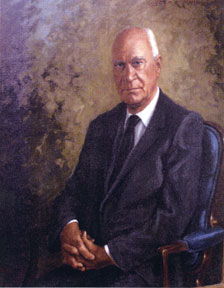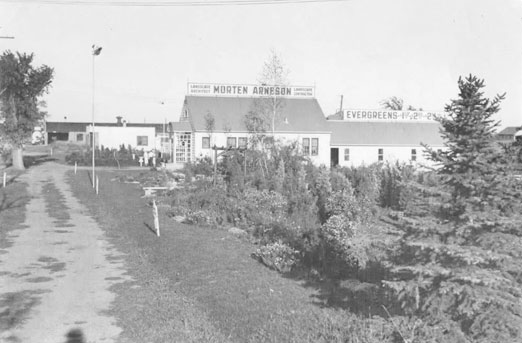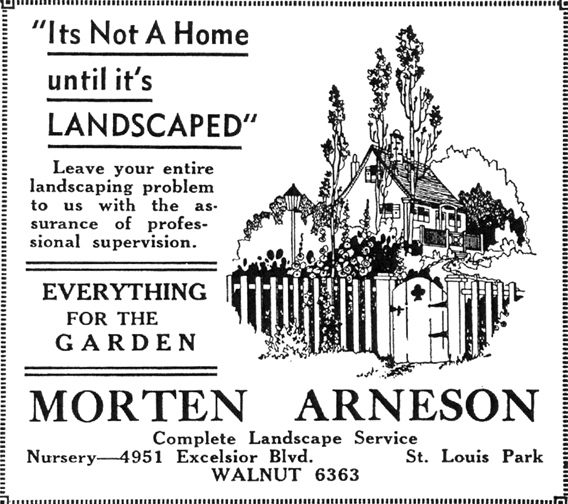Morten Arneson was a nurseryman on Excelsior Boulevard, but he was much more than that. He was instrumental in the creation of the St. Louis Park Medical Center (now Park Nicollet) and he was an extremely active participant in civic matters in the Park.
Arneson was born in Norway in 1893, and kept his Norwegian accent for life. He came to Minneapolis in 1912, and worked as a landscape architect for the Minneapolis Park Board, where he was the head of the flower department for 17 years.

In May 1929 Arneson bought three acres on Excelsior Blvd. and Quentin Avenue and established his nursery business at 4951 Excelsior Blvd. He probably bought the property from Warren C. Fletcher, who at one time had over 9 acres. Arneson and his wife Katharine lived in a little white house on Quentin, and the business operated out of a 4-5 car garage.


LIFE ON THE BOULEVARD
In his memoir, Arneson described the lawless, noisy atmosphere on Excelsior Blvd. once beer was legalized in April 1933. There were a reported 14 honky-tonks on the strip. He told of one particularly hot night when the racket was worse than ever; the band in the joint across the street (probably Walt’s Canteen, across Quentin) only knew three numbers on the banjo, one after another, and when they were through they started all over again.
Finally, the family departed to a friend’s house way out of town to get some sleep. He suspected the Kid Cann gang and the police (and possibly the Park Mayor) of being in cahoots with each other. Regardless, although the law that required establishments to close at midnight, it was not enforced, and those who complained were told to go back to Minneapolis if they didn’t like it. For more on this sort of thing, see Liquor in the Park.
To combat this lawlessness, Arneson and other residents formed the Better Government League, with the goal of finding and promoting candidates for election who would replace corrupt politicians. The League’s first success was getting Roy O. Sewall elected mayor. Sewall immediately fired the police chief and hired Andy Nelson, who served St. Louis Park very well for many years. The Better Government League talked more good people into running for the Council, and the Village started to turn around. From 1935, and throughout its existence, until 1953, Arneson was the only Chairman.
THE PLANNING COMMISSION
When Arneson found that the Planning Commission was not actively planning for the growth of St. Louis Park, he got himself appointed to the Commission. He worked to get people appointed who could provide positive, professional, and knowledgeable input. He spent 25 years on the Planning Commission during the period that was an exceptional time in St Louis Park’s growth. During this time, St. Louis Park was completely rezoned and it is still zoned very much the same today.
THE CHARTER COMMISSION
Arneson’s biggest contribution was on the Charter Commission. The Better Government League set up a committee, including Arneson, to study the best form of government for municipalities. They quickly settled on the Council-Manager type. It put the administration in the hands of hired professionals and left the elected officials free to look at the big picture.
The first Charter proposal failed to pass and it was decided that it was because it was not a very good charter. The Better Government League supported a second Charter Commission. Arneson also served as Chairman of this Commission, which included several well-qualified attorneys. They worked for four years before they proposed a vote on it. The Charter they wrote is the one under which the City operates today.
There was no viable opposition to this Charter and it was assumed that it would pass. Last minute opposition to Arneson personally developed and this Charter failed. In 1954, this same Charter was put to a vote and passed. By this time, Arneson had moved to Edina. Others were less kind. In a history of St. Louis Park commissioned by rival Carroll Hurd in 1976, Arneson is barely mentioned. In addition, only two lines were devoted to the St. Louis Park Medical Center, presumably because of Arneson’s association.
ST. LOUIS PARK MEDICAL CENTER/PARK NICOLLET CLINIC
From the very beginning, Morten Arneson was the champion of the St. Louis Park Medical Center. In 1951 he leased part of his land to the founding doctors of the St. Louis Park Medical Center on terms they could afford, thus allowing them to build their building. The final agreement was very one sided and the terms were very financially beneficial to the Medical Center for many years to follow. In their first meeting, Mr. Arneson became the agent for their welfare and success. As the building was going up, Arneson was on the site every day. He provided the water, the electricity, the phone, some extra planks and whatever was needed, all for free. Through the first years of the Medical Center, he remained encouraging and/or critical of their expansion plans. The St. Louis Park Medical Center honored Morten and Katherine by naming a new building in their honor. For more information about this very important aspect of the Arnesons’ lives, see Park Nicollet.
On his remaining St. Louis Park land, Arneson built a grocery store at 4951 Excelsior Blvd., on the corner of Excelsior and Quentin, in 1953. That building was later purchased by the burgeoning SLP Medical Center and is now the Park Nicollet MRI Imaging Center.
AL ARNESON
Nephew Al Arneson was born on July 22, 1918, three months after the death of his father, Albert A. Arneson, who was Morton’s brother. Al’s mother was Mrs. Elizabeth Arneson. Al was raised by Morten and Katherine, and many held the mistaken believe that Al was their son. Al attended Brookside School and was captain of the football team at Park High, graduating in 1935. He studied architecture at the U of M, graduating in 1940. In 1941 he earned a Masters at Harvard and went to work for General Housing, Inc. He trained in the theory of bomb damage to structures at Princeton.
When World War II broke out he became an operational analyst with the 13th Army Air Force, analyzing targets and determining their vulnerability. This work didn’t require him to take part in battle, but he requested permission to take part in order to analyze the effects of air attacks. He died on May 5, 1945, of a head wound in Tarakan, Borneo. He was survived by his aunt and uncle, mother (listed as of Lindley Hall, Minneapolis), and a sister, Mrs. Astrid McCleave of New York City.
EDINA
In 1953, Morten and Katherine built a house at 4709 West 70th Street in Edina, on 20 acres they had been using to grow nursery stock. Against pressure to subdivide, he donated his property to the City of Edina for use as a City park. Katherine passed away in 1972, and Morten passed away in October 1982. Their house is now being used for the Edina Historical Society. The tree farm is preserved as Arneson Acres. We’re told Morten’s ashes are located in an unknown location on the property.
